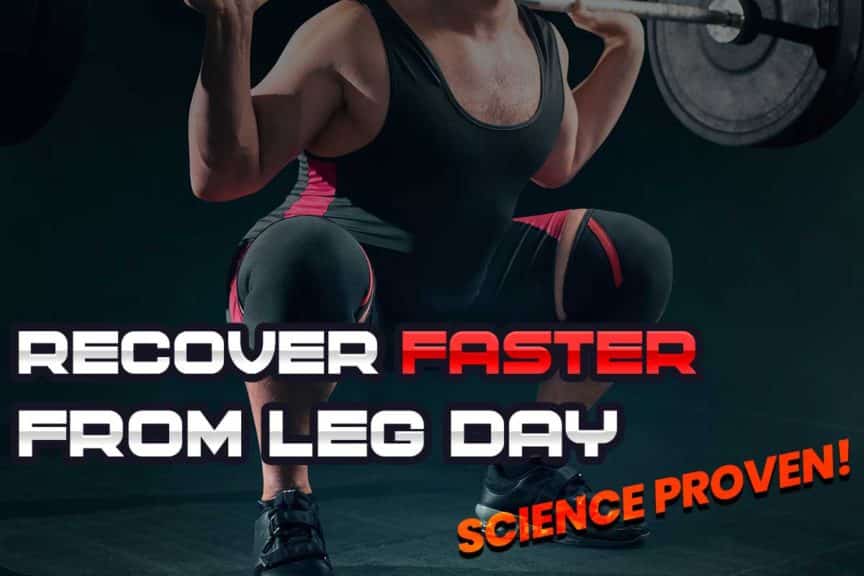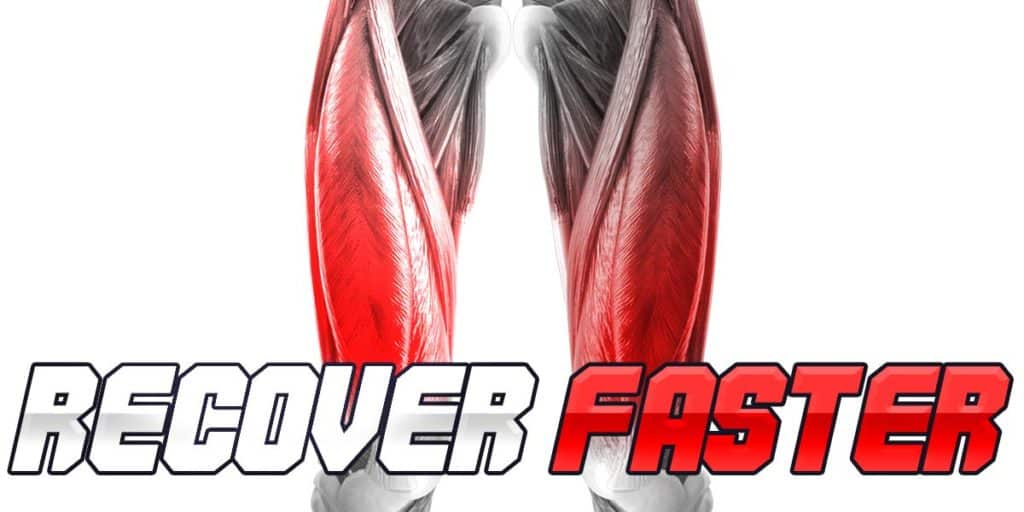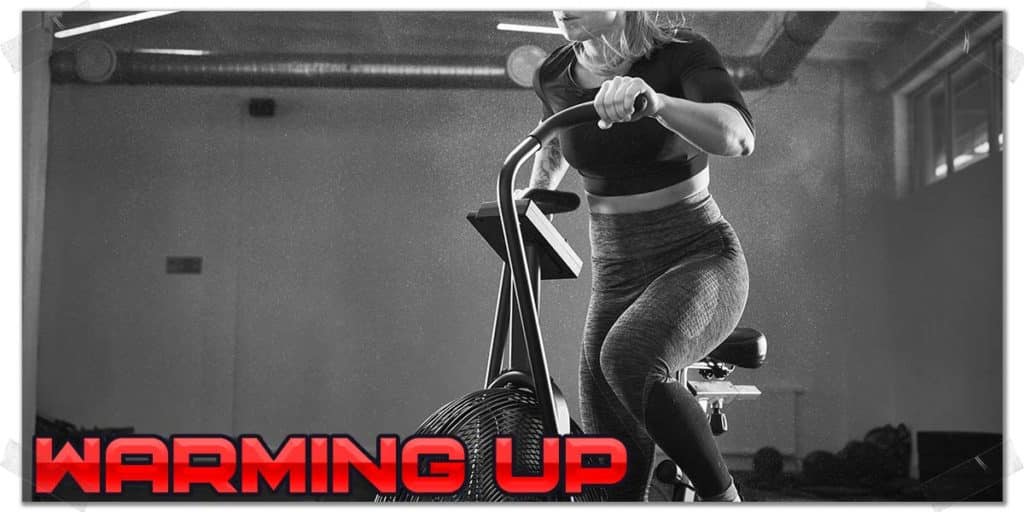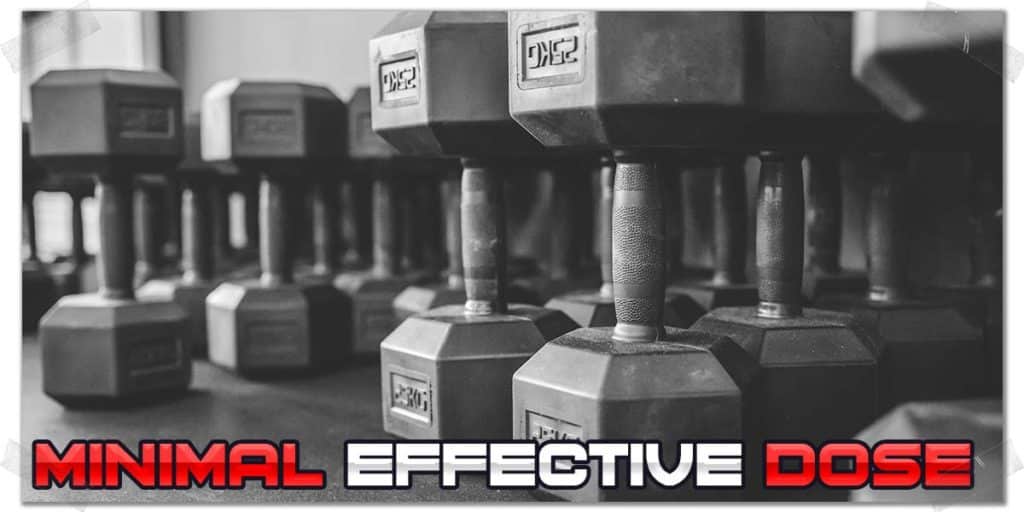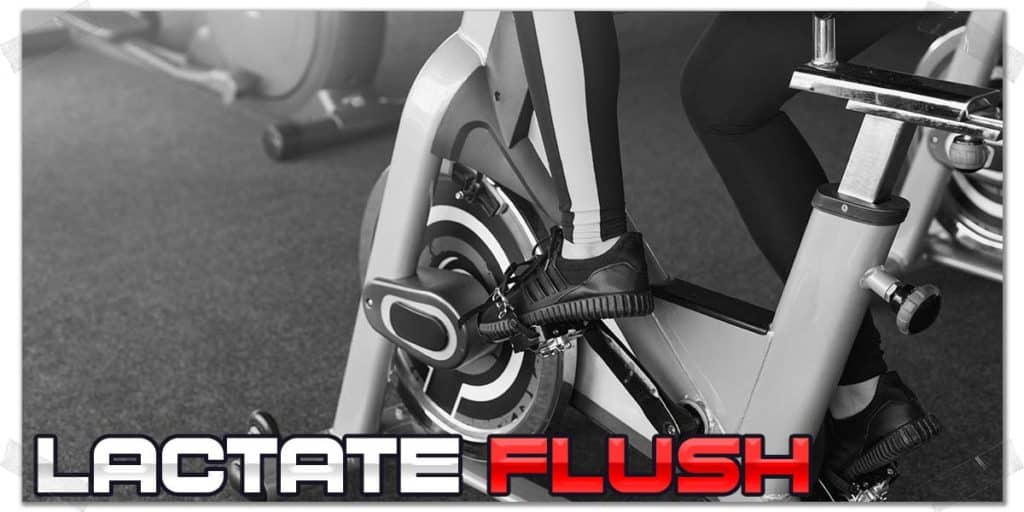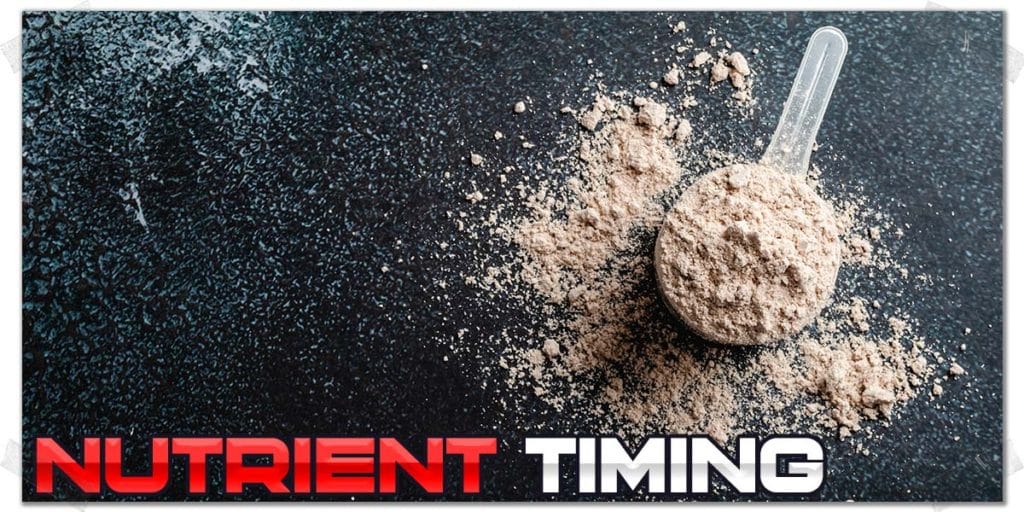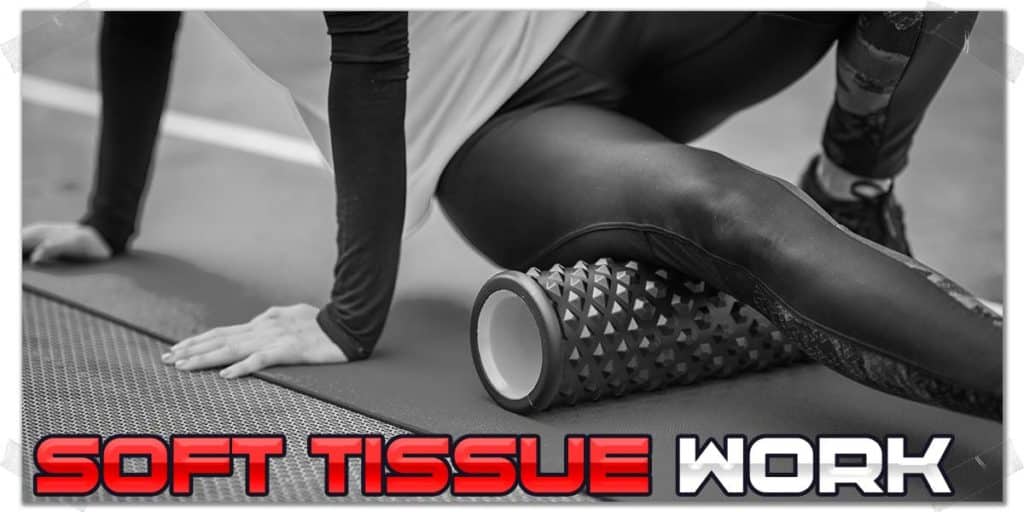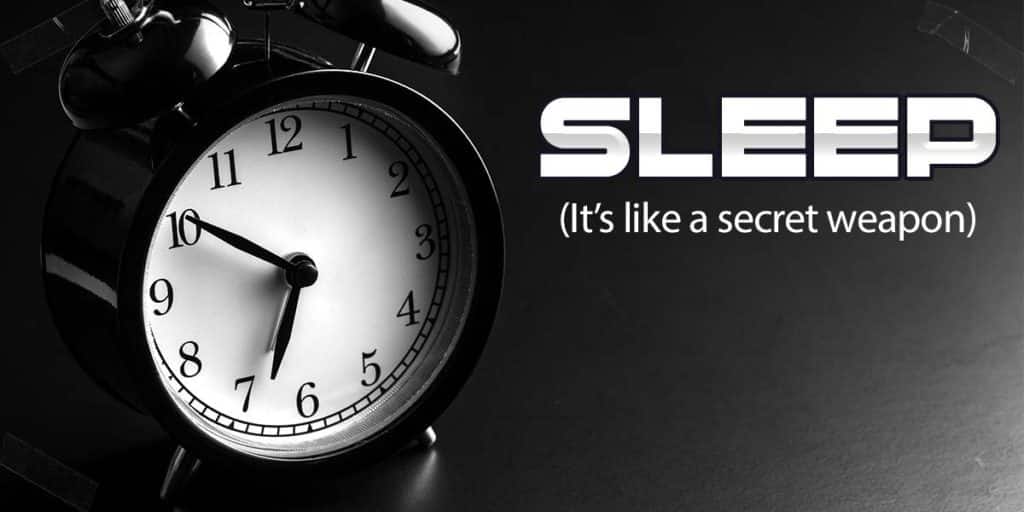Faster recovery after leg day is entirely possible if it’s something that you want to achieve, and the science to back this up is quite irrefutable. Not only does faster recovery mean less training time lost to the recovery process, but it also means that you’re simply not feeling as miserable in the days that follow your training session. So, read this article if you want the proven steps to take to optimize the entire recovery process after a lower body workout or activity session, AKA leg day.
Faster recovery from leg day involves optimizing your warmup and workout parameters, performing a lactate flush immediately after your training, optimizing your nutrient intake and timing, performing targeted soft tissue techniques, minimizing stress, and getting adequate sleep.
Each of these steps involves a handful of factors and details that need to be unpacked, assuming you want to get the most out of each one (which will help drastically cut down on your recovery time). And if you’re going to take action with faster recovery, you want to get everything out of each step that you can, right?
Related article: Supplements: Free Resources to Tell if Yours Are Safe & Effective
To start things off, we need to determine what you mean by the term “recovery,” since this can mean different things to different people. I’ve written this article under the assumption that you’re looking for interventions that will achieve two specific outcomes pertaining to your leg day recovery:
Outcome 1: Reducing the extent and length of time you feel physical muscle stiffness and soreness from your workout. Post-workout muscle soreness (delayed onset muscle soreness, or DOMS, for short) can be unpleasant to experience and, as such, is one common reason why individuals want to speed up the duration of this phenomenon.
Outcome 2: Minimizing the overall amount of time before the leg muscles can be adequately stimulated again in another training session. The more often you can effectively train, the more training gains you can reap.
What follows in this article are validated tips and insight that can help adequately address both issues. Hungry for these outcomes? Keep reading!
The big picture with recovery
Whether your leg day routine consists of heavy squats, deadlifts, sprinting, jumping, or any other form of physical exercise, recovery is much more than what you simply do immediately after a workout or training session; if you’re serious about your training and performance, recovery should be thought of an active, ongoing process taking place any time you’re not engaged in a workout or training session. No, this doesn’t mean you’re sitting around doing nothing but resting; recovery is a dynamic process that involves resting from demanding physical activities while implementing active strategies to accelerate and optimize functioning.
If you’re serious about maximizing your speed of recovery after a lower body workout, you want to utilize strategies that can be implemented immediately before your workout, during your workout, and after your workout. Collectively, these will yield a synergistic recovery effect far greater than any one individual action by itself.
Now, if you’re already sitting here reading this with sore legs, not all is lost; I assume there will be future leg days yet to come for you. So, read over the following sections rather than simply jumping to the “after workout strategies” so you’ll be able to implement every recovery strategy before your next lower body session.
Alright, let’s take it from the top on how to recover faster from a solid leg day session.
Proper warmup
Most individuals erroneously think that “faster recovery” or “recovery techniques” only refer to actions taken once a workout or physical activity session is completed. This simply isn’t the case. If you want a faster recovery, you need to start by optimizing your warmups.
A proper warmup before leg day helps ensure muscles, tendons, and joints of the lower body don’t incur unnecessary mechanical stress or strain that can lead to additional soreness. Warm, supple tissue is prepared tissue. Prepared tissue is effective tissue, and as such, it can better tolerate mechanical stress than tissue that is not.
Ideal warmup parameters and techniques
There’s no such thing as a universally perfect lower body warmup; there are a nearly infinite number of individual factors that will dictate what is most ideal for your own body. Nonetheless, some universal principles can be applied and followed. These include:
- Elevating your body’s core temperature and breaking a light sweat
- Performing a series of dynamic movements that help to mobilize the joints of the lower body
- Performing one or more soft tissue techniques to help further prepare the muscles and tendons for the upcoming training session.
If you want to learn the science behind effective dynamic warmups, you can check out my science-backed article on why dynamic warmups are so effective (and how to do them), or you can watch my YouTube video below!
Minimal effective training dose
If you want a faster recovery from sore legs, start by avoiding generating excessive, unproductive soreness in the gym. Yes, training hard and pushing yourself is a cornerstone to becoming a bigger, leaner, faster, and stronger individual; however, the smartest lifters and athletes know that effective training means training to stimulate muscles, not to annihilate them.
This is where the concept of minimal effective training dose comes in.
Here’s the analogy: If you had a headache and knew you could get rid of it entirely with one single tablet of aspirin, why would you take more than that? Swallowing three or four tablets won’t add to the benefit since one tablet achieves the desired effect.
Strength training, conditioning, and general physical exercise rely on the same concept; if your job is to provide a mechanical stimulus to your muscles to make them bigger or stronger, once you’ve provided that stimulus, you’ve done what you’ve needed to. Excessive sets and repetitions after this point won’t further the goal of doing what’s already been done.
Now, there are some important points to unpack here. For starters, your minimal effective training dose will be different than the next individual’s and will be primarily determined by:
- Your specific training goals or needs
- Your overall health and state of conditioning
- The types of exercises you’re performing
- Your overall training intensity (how heavy you’re lifting, how fast you’re sprinting, etc.)
Pro tip: If you’re just starting up a new routine or are new to the fitness game, ease into your routine over a series of workouts or training sessions; going full-out with high volumes of training or high training intensity is likely only going to cause excessive amounts of soreness and fatigue in your legs.
How to determine your minimal effective training dose
Knowing about the concept of minimal effective training dose is one thing; knowing how to effectively implement it for your training needs is another. Ultimately, it will come down to two factors:
Factor 1: How much of an expert you are on your own body. This expertise is largely the product of time and experience performing physical activity within your own body. Generally speaking, the longer you’ve been involved in a physically active lifestyle (lifting weights, playing sports, performing cardio training, etc.,) the more in-tune you’ll be with your body and what it needs.
Factor 2: How well-versed and up to speed you are with the scientific literature for training that aligns with your needs and goals. There’s perhaps some room for a little bit of “bro science”; however, making scientific research the bedrock of your reasoning for your training methodologies should be the goal.
Lactate flush (clearing metabolites)
By this point, you know how to begin to reduce muscle soreness by using an effective warmup before your session and minimizing it further during your workout. Now, we need to know what to do immediately after the session. And arguably, the most effective scientifically-proven action to decrease recovery time is performing a lactate flush, which is known as a form of active recovery (as opposed to passive recovery, in which you only recover by physically resting).
Lactate (often called lactic acid) is the metabolic junk that accumulates within the body (and muscles) as a byproduct of intense muscular effort. The hydrogen ions associated with lactate lead to the muscle burn and soreness we tend to feel once we’ve pushed our muscles to the point of fatigue. When elevated concentrations of these metabolites remain in the muscles, the result is a prolonged sense of soreness.
Lactate can be cleared from within the muscles at an elevated rate when elevated amounts of blood flow are pumped through the muscles. This is best done with an activity that raises your heart rate for a certain length of time and uses skeletal muscle pumping, which clears lactate from within the muscles, reducing soreness.
Pro tip: The skeletal muscle pump refers to the physical movement (pumping) of blood that occurs when a muscle contracts. The physical contraction of muscle fibers squeezes the capillaries (tiny blood vessels) within the muscles, forcing the blood within them to move along throughout the circulatory system.
For most gym-goers, the most practical way to perform a lactate flush after your lower body workout session is to hop on a stationary bike (and follow the parameters I discuss below). Not only is this a very common and accessible piece of equipment, but it also affords the ability to finely tune the speed and intensity of movement, which optimizes blood flow into muscles and the skeletal muscle pumping phenomenon.
How to perform a lactate flush
According to a study by Martin et al. (1998), here’s how to perform a highly effective lactate flush.1 This protocol produces far superior lactate clearance rates when compared to passive recovery or sports massage:
1. Within a few minutes of finishing your leg workout or activity, hop on a stationary bike.
2. Set the bike to a resistance level that allows you to pedal at 80 RPM and maintain a heart rate of approximately 60% of its maximum (which correlates to around 40% of your VO2Max).
3. Pedal continuously at this intensity for approximately 20 minutes.
According to Martin et al., this protocol can yield upwards of 60% greater lactate clearance after a lower body workout than passive recovery alone.
The flush should not be exhausting by any means; it should keep your breathing a bit elevated and your body warm. Putting more fatigue into the system at this point is not the goal, so if you feel that the flush is tiring out your legs even further, you’re likely spinning at a speed or intensity that exceeds ideal effort levels.
If done correctly, this lactate flush will noticeably cut down (but not necessarily eliminate) the muscle stiffness and soreness you will feel over the next day or two following your training session.
Heating vs icing strategies
Regarding post-workout strategies involving heating or icing strategies, there’s no shortage of different methodologies and protocols to try. The trouble is that the scientific literature seems to be somewhat mixed when determining if one temperature strategy (i.e. ice vs heat) is superior to the other.2
Numerous high-level studies have shown that heat can effectively reduce delayed onset muscle soreness (DOMS). In contrast, others have found that it may not be overly beneficial. The same can be said for what the scientific literature has found regarding cryotherapy (icing) strategies. Want the proof? Check out this 2021 meta-analysis by Wang et al.
Traditional heat therapy interventions can include:
- Hot packs (local treatment)
- Saunas, steam rooms and jacuzzi tubs (full body immersion)
Traditional cryotherapy interventions can include:
- Ice packs (local treatment)
- Ice baths & showers (full body immersion)
And then, there is contrast therapy, which alternates between periods of exposure to cold water to hot water, typically via the shower. Contrast therapy also seems to have mixed levels of evidence and support for its use in muscle recovery.3 Want the proof for that? Check out this 2017 meta-analysis by Higgens, et al.
Related article: Get MAXIMUM Motivation to do Cold Showers with These Strategies
Ice or heat: what’s the verdict?
The good news here is that despite the somewhat murky scientific findings, there’s likely room for either form of treatment, assuming you’re an otherwise healthy individual. Remember, whether you use ice or heat, this strategy should only make up a portion of your recovery interventions.
Some individuals absolutely swear by heat, while others swear by ice. It may be worth taking some time to experiment and find what your body tolerates best. While I advocate utilizing an evidence-based approach for most of one’s physical pursuits, I also acknowledge that there are times when it’s likely wise to rely on our own anecdotal experience and intuition.
Pro tip: If you opt to use heat, be aware that it takes approximately 20-minutes for heat from a heat pack to penetrate roughly 2 centimeters deep into the tissue being heated.
Protein & carbohydrate intake
If your body is going to have the best chance possible of recovering, you need to fuel yourself accordingly — both during and after your workout or activity session (and even before, but that’s for another article altogether).
The optimal diet and nutritional protocols — just like with physical training — are highly variable and specific to each individual based on their own health and training needs. But, again, general principles can be used to lay the foundation for dialing in these specifics thereafter.
Eating enough protein
Whether you get your protein from meat or from mixing your amino acid profiles from plant-based sources, eating adequate amounts of protein is one of the central tenets of optimizing your body’s recovery rate following a leg day session. Without enough protein, your body does not have the necessary resources to repair your leg muscles (or any other muscles, for that matter) following your workout. Inadequate amounts of protein will significantly impede your body’s ability to recover following leg day.
How much protein to eat
The exact amount of protein you should consume will vary significantly based on numerous factors, including:
- Your overall current health
- Your age and your biological sex
- Your training goals (performance-based, aesthetics based, etc.)
Regardless of these factors, if you’re regularly consuming less-than-adequate amounts of protein in your daily diet, your recovery will suffer.
If you want trusted and accurate information on determining your ideal protein amount, I’d check out this optimal protein intake guide (PDF) from the folks at examine.com, where they break down all of the most up-to-date findings in an easy-to-understand format.
Here’s the quick breakdown, in case you don’t want to sift through the document:
Both tables below come from the optimal protein intake guide mentioned above. I have simply pulled the data from the charts within the PDF for your convenience.
Carbohydrate ingestion
Carbohydrates are your body’s primary fuel source, and they’re the fuel you expend most when working out. While carbohydrates can be available in different forms, glucose (a type of sugar) is the most readily available fuel in the body, breaking down from its more complex form of glycogen.
Without adequate carbohydrate intake after your workout, muscle recovery (and thus, your performance) will be significantly impeded. As such, ensuring you’re taking in carbohydrates (in the form of solids and liquids) during and after your training session will significantly improve your body’s ability to recover at a faster rate.4,5
Read the following section below if you want details on a recommended post-exercise carbohydrate protocol, read the following section below!
Nutrient timing
While regularly eating an all-around healthy diet will help optimize your body’s overall ability to recover after physical activity, you can very likely get an added boost in recovery by ingesting some post-workout nutrition within an hour or two after your leg day session.
There’s no one single method or protocol for doing so; however, consuming some post-workout nutrition in liquid form shortly after a workout can have a few added benefits:
Benefit 1: Consuming carbohydrates and protein in liquid form (sports drinks, protein shakes, etc.) can be easier to digest on your GI system than solid foods and, as such, can cause less gastrointestinal distress.
Benefit 2: Liquids are much more quickly absorbed by the GI tract than solid foods, with the latter needing to be further broken down before absorption occurs.
Benefit 3: Liquids tend to be much more convenient for those on the go and who don’t otherwise have time immediately after their workout to sit down and eat a solid meal.
As well, consuming liquids can help ensure overall hydration status, which has been shown to be correlated with muscle function and recovery following physical activity.
Carbohydrate intake timing
If you want to give your muscles (and thus, your body) an elevated boost in recovery, ingesting some carbohydrates every few hours after your workout has been shown to help aid muscle function and recovery. Particularly, muscle glycogen resynthesis after exercise tends to be greatest within the first two hours, at which point the body has a higher affinity for taking in and utilizing glucose.
While the details are beyond the scope of this article, scientific literature suggests taking in about 0.7 grams of glucose for every kilogram of body weight every two hours for up to six hours after an exercise session is ideal for maximizing muscle glycogen recovery.5
Pro tip: A sports drink can offer simple forms of carbohydrates that can be readily consumed immediately after an exercise, and the added benefit of electrolytes (sodium and potassium) in the sports drink can be of further benefit if you’ve had a rather intense workout that involved excessive amounts of sweating.5
If you want more information on this topic, check out this fantastic document: Sports Drinks: Basic science and practical aspects.
Protein intake timing
While the scientific literature waffles back and forth a bit on whether or not you can get some added benefit by ingesting protein immediately after your workout, there’s enough evidence to consider it a valid strategy to try.4,6 However, it likely won’t produce enough of an effect to you feel a noticeable difference in reducing post-workout soreness.
The theory/evidence behind ingesting protein within the “anabolic window” after a workout is that the body will partition (break down and utilize) the protein more effectively right after your session than when not having just exercised. It’s more validated with carbohydrates than protein; however, ingesting protein immediately (within an hour or two) after a workout can also help improve recovery through additional means.
To read up a bit more on the science behind post-exercise protein intake timing and its potential benefits, check out this article for a starting point: Ingested protein dose response of muscle and albumin protein synthesis after resistance exercise in young men
Soft tissue work
Your muscles are like the engine of your car — they’re what allow physical movement to occur. As such, the harder or more frequently you put them through demanding exercises or activity sessions, the more often you’ll likely need to service them to ensure they stay in tip-top shape. Thankfully, much of this work can be done on your own.
Related article: Rumble Roller Vs Foam Roller: How to Choose Which One to Use
Muscles that are tight, bound down, and otherwise immobile will not only function in a sub-par manner, but they will likely also exhibit sub-par recovery capacity. Some regular dedicated soft tissue treatment to your leg muscles can help ensure the muscle tissue is operating at the healthiest capacity possible, which will ensure improved abilities in both speed and capacity for recovery.
Developing a brief lower body routine for both immediately after a workout as well as on days that follow leg day will provide numerous physiologic benefits to the muscles, including:
- Reduced delayed onset muscle soreness (DOMS)
- Increased blood flow to the muscles, which can help reduce muscle tension
- Reduce fascial restrictions, improving mobility
Short of getting professional massages and other therapeutic treatments, there are multiple actions you can take on your own to give your muscles some love, many of which have varying levels of scientific evidence behind them. Some of the simplest and most practical methods you can perform by yourself include:
- Foam rolling the quads, adductors, glutes, and hamstrings
- Barbell sleeve rolling the muscles mentioned above
- Light muscle activity, such as walking or yoga exercises
All of these interventions have been shown within scientific literature to help improve muscle recovery and capacity to specific extents. The key will likely be for you to try each one and determine which ones feel best for you.
When to perform soft tissue work?
In short, these soft tissue treatment techniques for muscle recovery can be performed immediately after a workout as well as at various other points throughout the day.
While there’s no single best type of treatment or protocol for performing soft tissue treatment (either by a professional or by yourself), here are some noteworthy bits of information on additional forms of recovery you may find interesting:
- Whole body vibration therapy has been shown to significantly reduce perceptions of delayed onset muscle soreness (DOMS), improve range of motion, and decrease pain thresholds while preserving maximal isometric and isokinetic muscle strength.7 For more information, take a look at this 2014 study by Veqar et al. As such, it seems to be a promising form of recovery following intense physical activity.
- Pressotherapy, when used in attempts to reduce delayed onset muscle soreness, has some positive effects in reducing symptoms, but these symptoms seem to be moderate at best, according to a 2022 meta-analysis by Wisniowski et al.8
- Foam rolling, which is arguably the most accessible and widely known form of self-soft tissue treatment, has shown to be effective in reducing DOMS, according to a 2015 study by Pearcey et al.9
Sleep
If you’re not going to take your sleep seriously, you might as well forfeit one of the most potent recovery interventions you could hope to have. The positive benefits of sleep on bodily repair and tissue synthesis are too numerous to mention within one single article. However, here are some of the scientifically validated recovery benefits that occur when you get optimal sleep:
- Sleep helps to reduce the overall catabolic (breakdown) process in the body by improving hormonal levels (such as by decreasing cortisol levels and increasing IGF-I and testosterone).10
- Sleep extension or napping has been shown to decrease sensitivity to pain, which is believed to play a factor in recovering from physical exercise.10
- Sleep deprivation has been shown to increase the rates of physical injury and athletes in addition to reducing cognitive functioning.10 By ensuring you get enough sleep, you’re not only recovering faster, but you’re also cutting down on your risk of becoming injured.
How much sleep should you get after leg day?
If you’re taking your training seriously, you’ll need to tack on a bit of extra sleep than if you were sedentary. While the amount of sleep that you’ll require can depend on your individual age and training intensity, here are some general rules when it comes to getting optimal sleep:
- The American Academy of Sleep Medicine and Sleep Research Society recommends that individuals over the age of 18 years old should, at a minimum, get 7 hours of sleep per night.
- Athletes and other physically active populations may likely need an additional hour or two for ideal sleep; however, this is likely to vary based on the needs of each individual athlete.11
Final thoughts
Train hard, recover harder. If you’re serious about becoming bigger, stronger, leaner, and overall healthier, your training will only be as effective as the recovery interventions that you use. The more effective your recovery, the quicker you can get back into the gym and do it all over again.
References:
3. Higgins TR, Greene DA, Baker MK. Effects of cold water immersion and contrast water therapy for recovery from team sport: a systematic review and meta-analysis. J Strength Cond Res. 2017;31(5):1443-1460.
5. Shirreffs SM. Post-exercise rehydration and recovery. Maughan RJ E Murray R Sports Drinks Basic Pract Asp. 2001;1.

Hi! I’m Jim Wittstrom, PT, DPT, CSCS, Pn1.
I am a physical therapist who is passionate about all things pertaining to strength & conditioning, human movement, injury prevention and rehabilitation. I created StrengthResurgence.com in order to help others become stronger and healthier. I also love helping aspiring students and therapists fulfill their dreams of becoming successful in school and within their clinical PT practice. Thanks for checking out my site!

